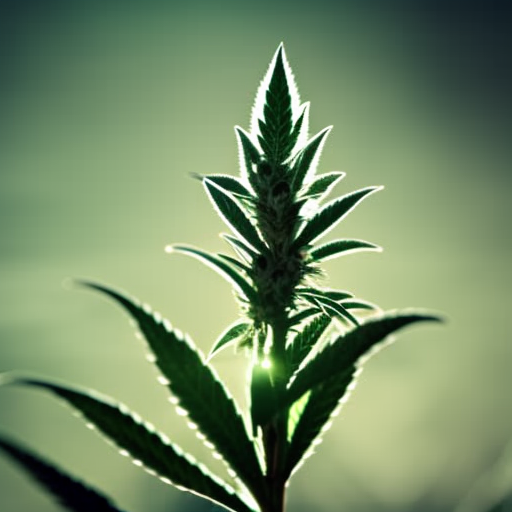
The Lowdown on How THC & CBD Get Made: Breakin’ Down the Cannabinoid Game!
Ayo, what’s good, fam? If you in the game of growin’ that green, you know what time it is. Most of y’all just tryna get those big, dank buds packed with that fire THC or CBD. Everybody knows that the potency be peakin’ at a certain point, then it starts droppin’. If you harvest too early or you wait too long, you gon’ mess up all that grind you put in. Ain’t nobody tryna waste time, ya feel me?
But let’s break down how the magic happens. Your plants ain’t just chillin’ under the sun. They workin’ hard on a molecular level, and it’s time we take a closer look at that cannabinoid biosynthetic pathway. Sounds fancy, huh? Let’s get into it!
CBGA AND CBGVA: WHERE IT ALL STARTS
Alright, first things first, before any cannabinoids pop off, they gotta make somethin’ called geranyl pyrophosphate. When that stuff hooks up with olivetolic acid, boom! You got cannabigerolic acid, or CBGA for short. If it rolls with divarinolic acid, then you get cannabigerovarinic acid, known as CBGVA.
This is where it all kicks off. Ain’t no THC or CBD without these building blocks. CBGA’s got a structure of C₂₂H₃₂O₄, right? That’s 22 carbons, 32 hydrogens, and 4 oxygens. CBGVA is kinda similar, sittin’ at C₂₀H₂₈O₄. Keep those numbers in mind, ‘cause the cannabinoids that come next will have a similar setup. They might drop a few atoms, but the differences come from how those atoms are arranged.
BIOSYNTHESIS CREATES THE ACID FORMS OF THE PRIMARY CANNABINOIDS
Next up, when CBGA and CBGVA get together with some special enzymes, they go through biosynthesis and transform into the acid forms of the main cannabinoids: THC, CBD, and CBC. Just keep in mind, these new formulas are near identical to CBGA and CBGVA, but each one loses some hydrogen atoms. The carbon and oxygen squad stay intact:
- CBGA + THCA-synthase = THCA (tetrahydrocannabinolic acid)
- CBGA + CBDA-synthase = CBDA (cannabidiolic acid)
- CBGA + CBCA-synthase = CBCA (cannabichromenic acid)
- CBGVA + THCA-synthase = THCVA (tetrahydrocannabivarinic acid)
- CBGVA + CBDA-synthase = CBDVA (cannabidivarinic acid)
- CBGVA + CBCA-synthase = CBCVA (cannabichromevarinic acid)
Now here’s the kicker: THCA, CBDA, and CBCA all got the same molecular formula of C₂₂H₃₀O₄. THCVA, CBDVA, and CBCVA chill at C₂₀H₂₆O₄. But just ’cause they got the same numbers, don’t mean they act the same. It’s all in the arrangement of them atoms.
Even though THCA and THCVA sound real similar to THC, they ain’t tryna get you high just yet. They gotta go through the next step to activate.
DECARBOXYLATION CHANGES ACIDS TO ACTIVES
Now, even if you harvest right on time, your bud still ain’t ready to get lit. They still in that acid form on a molecular level, which is why munchin’ on raw weed don’t do a thing. To get that high, they gotta go through decarboxylation (decarbed for short). This process is where the heat comes into play.
When you cure it, it kinda starts to decarb, but heat is where the real magic happens. When you smoke or vape, it’s instant, but for edibles, you gotta do some prep. Most recipes will tell you to decarb in the oven first before throwin’ it in the mix.
So what’s happening in decarboxylation? You lose one carbon and two oxygen atoms from each molecule. That’s why it’s called what it is. For that THC magic, heat your dried herb at 120°C for about 20 to 30 minutes. If you tryin’ to keep them terps, go low and slow. For CBD, crank it to 140°C for 60 to 90 minutes.
After all that, you got your new cannabinoids:
- THC (tetrahydrocannabinol)
- CBD (cannabidiol)
- CBC (cannabichromene)
- THCV (tetrahydrocannabivarin)
- CBDV (cannabidivarin)
- CBCV (cannabichromevarin)
They all hold the same formulas, but that atomic structure is what gives them them unique vibes.
WHAT ABOUT PLAIN OLD CBG?
By the time those plants are ready for the harvest party, most of that CBGA has turned into THCA, CBDA, and CBCA. The little bit that’s left flips to cannabigerol, or CBG, when you hit it with some heat. CBG is different from THC, only by two hydrogen atoms.
To keep it simple, here’s a quick rundown:
- CBGA: C₂₂H₃₂O₄
- THC: C₂₁H₃₀O₂
- CBG: C₂₁H₃₂O₂
So, these transformations ain’t just a couple of atoms bouncin’ out. The rearrangement creates totally new compounds that act way differently from each other.
CBG is an active, minor cannabinoid that ain’t gettin’ studied much, but it’s thought to help with pain and might even fight cancer. But like CBD, it ain’t gonna get you high, so don’t trip. If you wanna try some CBG-heavy herb, you gotta chop it down a few weeks before peak ripeness.
DEGRADATION OVER TIME DOES THE REST
If you let cannabinoids just chill, they gon’ change again with time and exposure to the air. We call this degradation. It can happen while still on the plant if you wait too long, or with cured weed that ain’t stored right. Degradation hits hard, weakenin’ even the strongest buds as the active cannabinoids turn into less desirable forms.
Check this, you can actually see THC change over to CBN (cannabinol) when you peep the trichomes. You’ll notice the color shift from milky to amber. CBN brings some mild psychoactivity, but it’s more of a chill vibe than a euphoric lift. If you wanna hit that couch lock, you might play around with harvest time until most of them crystals shift color.
Going from THC to CBN just needs four hydrogen atoms to bounce, changing the formula from C₂₁H₃₀O₂ to C₂₁H₂₆O₂. But shifting from CBD to CBE (cannabielsoin) is a whole different game; it actually picks up an oxygen atom, rolling to C₂₁H₃₀O₃.
To keep your herb from degrading fast, watch these four conditions:
- Temperature: Store that bud at 20°C or less.
- Humidity: Keep the humidity around 60% in your stash spot.
- UV Light: Dark places are your friend; keep it away from sunlight.
- Oxygen: Airtight containers are key to slow down oxidation.
At the end of the day, cannabis is a plant just like any other fruit or veggie—it ain’t gonna last forever. When treated right, it can live long and prosper. Extracts hold onto their potency longer, but they too will eventually lose strength.
THE CANNABINOID PATHWAY—IN CONCLUSION
Who would’ve thought these cannabis plants be hustlin’ so hard on a microscopic level? They could be doin’ way more than we even know. Science keeps dropin’ knowledge every day about these magical plants. One thing’s for sure: there’s so much more for us to discover. So stay curious, stay informed, and keep grinding!




